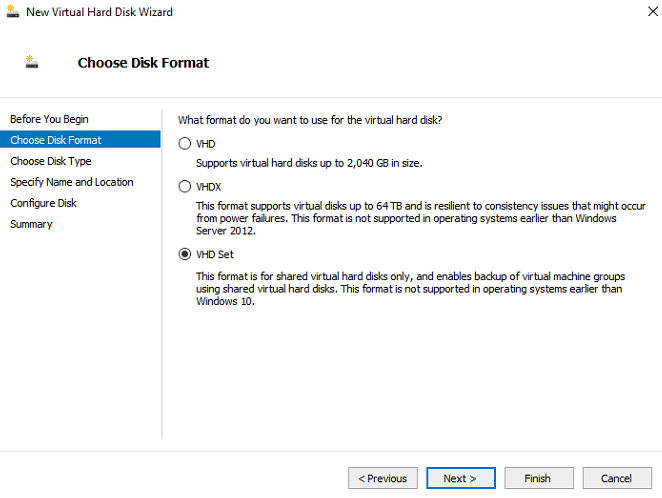Virtual disks -VHD Set (VHDS) in Windows Server 2016 is one of the useful innovation. VHD set: shared virtual disks on hyper-v 2016 allows the use of one virtual disk simultaneous by multiple virtual machines.

As a part of our Server Management Services, we help our customers to create a new VHD Set on Windows Server 2016.
Let’s see how our Support Engineers help to set this up.
Why choose VHDS over VHDX ?
Features of shared VHDX were replaced by VHD set as it does not require the configuration of virtual HBA and SAN for the presentation of one LUN to several VMs.
VHDX has drawbacks which does not allow us to change the size or migrate and also do not support backup, whereas VHDS overcomes all these drawbacks and allows hot disk migration and host-level backup.
VHD set: shared virtual disks on hyper-v 2016 do not have these restrictions, but it is available only in the VM running the guest Windows Server 2016.
Steps to create a new VHD Set (VHDS):
1. Go to the Graphical menu of Hyper-V Manager.
2. Select New -> Virtual Disk.
3. Specify VHD Set as disk format.

4. Select the type of disk (fixed or dynamic).
5. Provide file name, location, and size.
When creating a disk of VHD Set format, two files appear:
- .avhdx – a disk file containing data (it can be both fixed and dynamic)
- .vhds – a small (260 KB) metadata file to coordinate the interaction between guest cluster nodes
[Need further assistance? We are here for you!]
Steps to create the disk using PowerShell (Alternative method):
New-VHD –Path c:\clusterstorage\vmstorage01\DynamicDisk.vhds -SizeBytes 40Gb -Dynamic
When creating a disk, it is enough to specify vhds file extension, and PowerShell will automatically create the VHD Set.
[Need help with PowerShell? – We’re available 24*7]
Example to create a wo-node guest cluster using VHDS:
We need to create two new VHD Sets for this, one Witness disk and a disk for data.
We can do this in the Hyper-V graphical interface or in PowerShell:
Add-VMHardDiskDrive -VMName VMCL01 -Path "c:\ClusterStorage\SharedDisk\VM_Quorum.vhds" -SupportPersistentReservations Add-VMHardDiskDrive -VMName VMCL01 -Path "c:\ClusterStorage\SharedDisk\VM_Shared.vhds" -SupportPersistentReservations Add-VMHardDiskDrive -VMName VMCL02 -Path "c:\ClusterStorage\SharedDisk\VM_Quorum.vhds" -SupportPersistentReservations Add-VMHardDiskDrive -VMName VMCL02 -Path "c:\ClusterStorage\SharedDisk\VM_Shared.vhds" -SupportPersistentReservations
Install Failover Clustering feature on each virtual server:
Install-WindowsFeature -Name Failover-Clustering -IncludeManagementTools -ComputerName VMCL01 Install-WindowsFeature -Name Failover-Clustering -IncludeManagementTools -ComputerName VMCL02
Initialize the disks:
get-disk |? OperationalStatus -Like “Offline” | Initialize-Disk
Create NTFS partitions:
New-Volume -DiskNumber 1 -FileSystem NTFS -FriendlyName Quorum New-Volume -DiskNumber 2 -FileSystem NTFS -FriendlyName Data
Now create a cluster:
# Compatibility check
Test-Cluster VMCL01,VMCL02
# Creating cluster
New-Cluster -Name FSCluster01 -Node VMCL01,VMCL02 -StaticAddress 192.168.0.50
(Get-ClusterResource |? Name -like “Cluster Disk 1″).Name=”Quorum”
(Get-ClusterResource |? Name -like “Cluster Disk 2″).Name=”Data”
# Specify the Witness disk
Set-ClusterQuorum -DiskWitness Quorum
# Add Cluster Shared Volume
Get-ClusterResource -Name Data | Add-ClusterSharedVolume
If the steps are followed in the right way we will get a two-node guest cluster.
[Need further assistance? – We’re available 24*7]
Conclusion
In short, we’ve discussed what is VHDS on hyper-v 2016. Also, we saw how our Support Engineers set up a new VHD Set (VHDS).
.







0 Comments